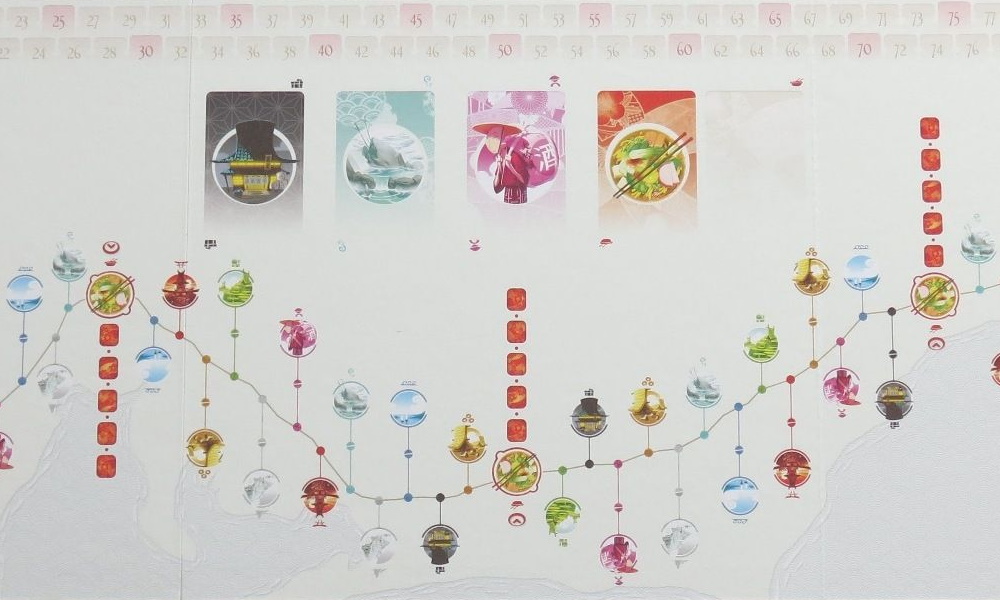Tokaido is a game I played a lot when I got into the hobby but I didn’t give it the blogging attention it needed.
Now is the time…
In Tokaido, each player is a traveller crossing the “East sea road“, one of the most magnificent roads of Japan. While travelling, you will meet people, taste fine meals, collect beautiful items, discover great panoramas, and visit temples and wild places but at the end of the day, when everyone has arrived at the end of the road you’ll have to be the most initiated traveller – which means that you’ll have to be the one who discovered the most interesting and varied things.
Tokaido Game Play
So you lay out the very long board and shuffle a few decks of cards.
Each player gets 2 random traveller tiles and picks one to play as their character. Each of these characters has an ability to use throughout the game. Players get a piece of their colour and place it to the left (West?) of the board.

Players also get an amount of starting cash depending on their character card.
In this game, players will take turns moving their character further down the road to the right (East?). The player that is furthest back on the track, goes next. This means sometimes a player can take multiple turns in a row.
Once a player moves their piece they take the action of that space:

Actions
There are 7 different spaces, let’s look at them:
Village: Draw 3 souvenir cards and buy as many as you like. Souvenirs come in 4 types and are kept in sets of different types in front of the player. You then score points for the number of cards in the set you added the card to. Gain 1, 3, 5, or 7 points.
Farm: Gain 3 coins.
Panorama: There are three types of Panorama space, Sea, Mountain, and Paddy. When you stop on one you take the lowest number in that panorama and score that many points.
The first player to complete a panorama gains the panorama achievement card which is worth 3 end-game points.
Hot Springs: Draw a hot springs card and score the points shown which will be either 2 or 3.
Temple: Players must donate 1 coin but can donate up to 3 coins. Score 1 point for each coin donated. This also contributes to some end-game scoring.
Encounters: Reveal the top card of the encounter deck and resolve. There are 5 different encounters:
- Travelling Merchant: draw the top souvenir and add it to a set, score that set
- Guide, take the next panorama card you need in any panorama
- Samurai, score 3 points
- Noble, gain 3 coins
- Shinto Priest, gain 1 coin from the supply and add it to the temple, gain 1 point
Arriving at an Inn
Inns: All travellers MUST stop at an inn to end their round and have a meal. The first player draws meal cards equal to 1 plus the number of players. That player can buy one and gain 6 points if they do.
The rest of the players can buy from those left as they arrive at the Inn BUT a player can not buy the same meal more than once in a game.
Once everyone is at the Inn, the next round starts continuing down the road. When the final player reaches the final inn, the game ends.

Players gain achievements worth 3 points each for the following:
- Gourmet – The highest value of meals eaten in the game
- Bather – Most hot springs cards collected
- Chatterbox – Most encounter cards collected
- Collector – Most souvenir cards collected
Then players score for the most donations made to Temples in the game. 1st 10 points, 2nd 7 points, 3rd 4 points and 2 points for everyone else that donated at least 1 coin.
The player with the most points wins.
Theme
The theme is really nice. It’s very rare to get a game with a theme this relaxed and is kept relaxed.
Apart from fighting over spaces, you just move forward. The stress comes from spaces you need being taken up and you not being able to buy a decent meal due to lack of money or getting there too late.
Setup & Rulebook
No setup really.
The rulebook is good, but there is also a lack of rules which makes it easy 🙂
Components & Artwork
Everything here is really nice. I mean, the components are standard quality but everything from the box to the board looks really nice.

A note on the graphic design too. Each action space has an icon that matches the back of its related card, they’re also coloured-coded. This makes things so easy to both teach and remember while playing.
Ease of Teaching & Accessibility
Very simple to teach.
It’s a mostly open information game so there are no accessibility issues I can see.
Tokaido Summary
I know the “whoever is at the back goes next” mechanism has been used before but I still call it the “Tokaido Mechanism”. It’s used in games in different ways like Dragon & Flagon as well as the shopping part of Francis Drake.
Patchwork is probably my favourite from recent years.
I said most of what I wanted to say in the Theme segment. The game is so relaxed BUT you are constantly tense about the spaces available to you. Maybe you can’t afford a meal and there is only 1 Farm space between you and the Inn, but someone takes it… You KNOW they can’t move out until you pass them… Argh!
The different characters are really good and give you a different thing to focus on each game, that’s always nice. In some games you’re flush with cash, the next you stop at every Farm you can!
The app! I nearly forgot to mention the app, it’s sooo pretty and really fun to play.

So, Tokaido is a very good “Tokaido” style game and because of this, I’m still attracted to this turn mechanism. It’s a game that, 8 years later, I’m still happy to play both digitally and physically.
Jesta ThaRogue



Leave a Reply